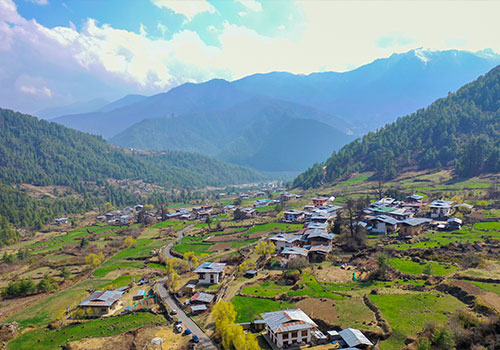Mailing List
Sign up for our mailing list to get latest updates and offers.
A Haven of Tradition Amidst Stunning Beauty
Nestled amidst the majestic peaks of the Himalayas lies Haa, a picturesque valley and district in western Bhutan. Renowned for its pristine environment, rich cultural heritage, and peaceful way of life, Haa offers a glimpse into the heart of Bhutan's unspoiled beauty. This comprehensive guide delves into the various facets of Haa, exploring its demography, history, culture, environment, and economy.
A Land of Tranquility and Hospitality
Haa is Bhutan's second least populated district, with a population estimated to be around 13,000 inhabitants. The ethnic composition is predominantly Bhutanese, with the main languages spoken being Dzongkha, the national language, and various local dialects. The people of Haa are known for their warm hospitality and adherence to traditional Bhutanese values, which emphasize respect for elders, community, and the natural world.
Whispers of Ancient Traditions
Haa's history stretches back centuries, interwoven with the rich tapestry of Bhutan. Evidence suggests early settlements dating back to the 7th century AD.. Haa played a significant role in the consolidation of Bhutanese power, with historical accounts mentioning the valley's contribution to the unification of the country under Zhabdrung Ngawang Namgyal in the 17th century. The prominent Haa Dzong, a fortified monastery, stands as a testament to the valley's historical significance.
A Tapestry of Tradition and Harmony
Bhutanese culture is deeply ingrained in the daily lives of the people of Haa. Villages resonate with the sounds of prayer wheels turning and monks chanting. Traditional dress, known as Gho for men and Kira for women, is a common sight. Festivals like the Tsechu, a vibrant celebration of Bhutanese heritage, are a major highlight, bringing the community together in a display of colorful dances, music, and religious significance.
One unique aspect of Haa's culture is the prevalence of animistic beliefs alongside Buddhism. The locals revere the natural world, evident in their respect for mountains, rivers, and spirits believed to reside in them. This harmonious co-existence between religion and nature forms the core of Haa's cultural identity.
A Breathtaking Paradise
Haa boasts a captivating natural environment, characterized by soaring Himalayan peaks, lush valleys, and pristine rivers. The majestic Jomolhari mountain, towering at over 7,300 meters, forms a dramatic backdrop to the valley. Diverse flora and fauna thrive in this eco-haven, with forests harboring species like the elusive red panda and the majestic takin, Bhutan's national animal. The Haa Chhu River, originating from Jomolhari, carves its way through the valley, providing a source of irrigation and lifeblood for the community.
The government prioritizes environmental conservation, and Haa is a prime example of this commitment. Sustainable practices are deeply embedded in the local way of life. Development is carefully monitored to preserve the pristine nature of the valley.
A Balance Between Progress and Tradition
Haa's economy is primarily based on agriculture. With fertile valleys yielding abundant crops. Animal husbandry, particularly yak herding, plays a vital role, providing essential dairy products and contributing to trade with neighboring regions. Tourism is a growing sector, with a focus on responsible and sustainable practices to protect the valley's unique character.
Haa's development is carefully balanced with the preservation of its traditional way of life. Industries are limited, and the focus remains on maintaining the valley's natural beauty and cultural heritage.
Exploring Haa:
A visit to Haa offers a truly unforgettable experience. Here are some highlights:
Haa Dzong: This imposing 17th-century fortress monastery is a significant cultural and historical landmark.
Lhakhang Karpo and Lhakhang Nagpo: These 7th-century temples, the White Temple and Black Temple respectively, are considered sacred pilgrimage sites.
Haa Valley: Explore the breathtaking scenery, charming villages, and serene monasteries nestled amidst the valley.
Homestay Experience: Immerse yourself in local life by staying with a family in a traditional farmhouse.
Shelkar Drak: Imagine a tiny, charming temple clinging to the south face of a majestic cliff. Shelkar Drak, much like the famous Taktsang monastery in Paro, appears to organically emerge from the rock face, creating a breathtaking spectacle.
Takchu Goemba: perched atop Avalokiteshvara Hill. This isn't just any hill; it's the crown jewel of the Three Mountain Sanctuary (Mi Ri Phuensum), a place where the majesty of the Haa Valley unfolds in all its glory.
Poppy Trail: Embark on a scenic hike through meadows bursting with colorful poppies during the spring season.
Nuptsho Na Patra: More than just a historical site; it's a portal to a bygone era, a place where nature and spirituality intertwine, and local legends come alive. So, lace up your hiking boots and embark on a journey to discover this hidden gem.
Panorama Trek: Isn't just a hike; it's an adventure for the soul, it offers a moderate challenge, perfect for adventurous trekkers. Its 11 km walk only.
